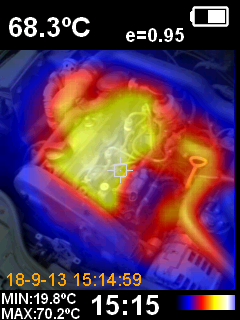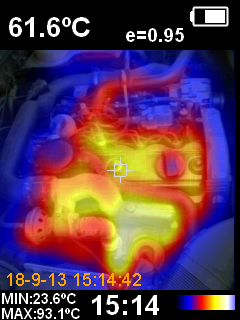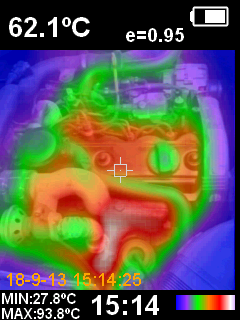Review: Thermal Imaging Camera HT-02
on

What do electronics designers and electronics repairers dream about? No, not the new FHM 2019 calendar... Dreaming about a thermal imaging camera, of course! However, most of these are in a price category that makes it seriously difficult to justify such a purchase. But this is slowly changing. In this review we look at the “Thermal Imaging Camera HT-02”, which has its origins — you already guessed it — China.
Description
The camera arrives in a reasonably sturdy cardboard box with a magnetic latch. It contains a fairly detailed English user manual, which, by Chinese standards, can almost be called excellent. The sturdy cloth case with belt clip, adjustable strap and a storage space for 4 spare batteries has a stiff shape and does not deform. The closure is made from hook-and-loop material and can therefore be opened and closed quickly. Because of the shape of the case and the 'lid', it already stays reasonably closed by itself.
The camera housing is made from grey plastic that for the most part is covered with a thick yellow coating that feels rubbery on the outside. As a result, the camera is not likely to inadvertently slip from your hand. Should that happen nevertheless, it looks like it could cope with a small bump anyway. The small cover on the top of the camera (under which is the SD card for the storage of recorded images) is made from a soft, flexible plastic/rubbery material.
The battery compartment is closed with a cover of the type that you can also find on a TV remote control, only sturdier. You do not require a screwdriver or other tool to open the battery compartment. The four AA batteries are easily inserted and removed.



Specifications
We quickly list a few of the salient specifications:
- Screen color screen with a diagonal size of 2.4” (6.1 cm)
- Resolution of the IR image 60 by 60 pixels (3600 pixels)
- Resolution of the camera: 0.3 megapixels
- Image angle: 20 x 20 degrees
- Focus distance: 50 cm
- Thermal sensitivity: 0.15 ºC
- Temperature range: -20 ºC to 300 ºC
- Accuracy: +/ 2% or +/ 2 ºC (4 ºF)
- Emissivity: Adjustable between 0.1 and 1.0
- Image update frequency: 6 Hz
- Wavelength: 8-14 µm
- Color palette selectable: Iron-red, rainbow, rainbow high contrast, grey values (white glow), grey values (black glow)
- Storage: BMP on SD card
- Power supply: 4 AA batteries
- Weight: 320 g
When we compare against the nearest competitors in a similar price category, for example the Flir One, we see that of the important specifications only the resolution of the 'normal' camera is somewhat behind. The other characteristics are much in the same range or even significantly above (temperature range of the Flir One is limited to 120 ºC). To be honest, the low resolution of 0.3 megapixels did not disturb me. For this small screen that resolution is sufficient and I don't see the need for a higher resolution when you consider the relatively low resolution of the IR image. Of course, you will see the difference when you store the photo and then view it on a computer monitor, but I won't call this absolutely essential. For this format of hand-held heat image camera, this is perfectly adequate.


Discussion (0 comments)